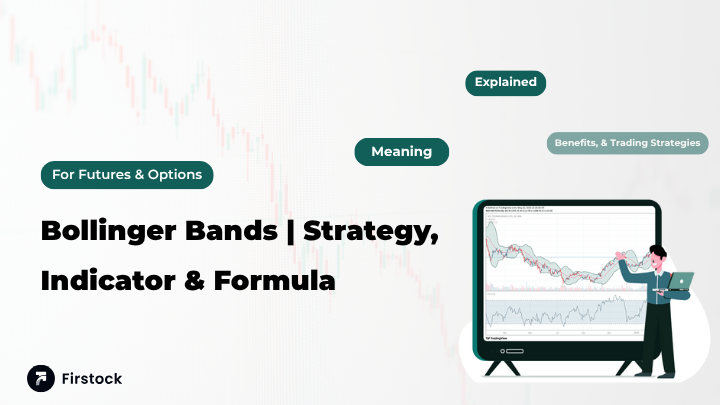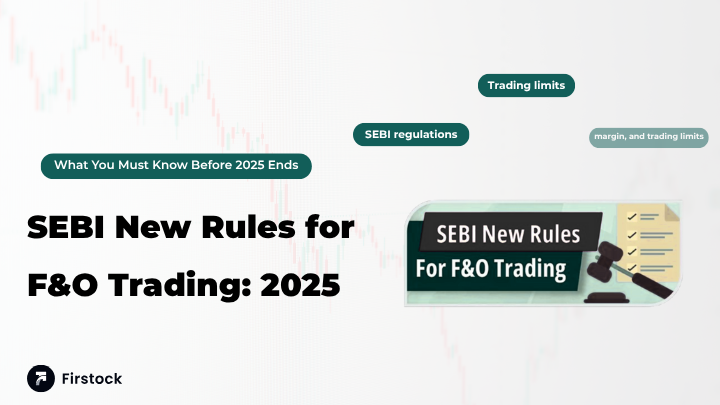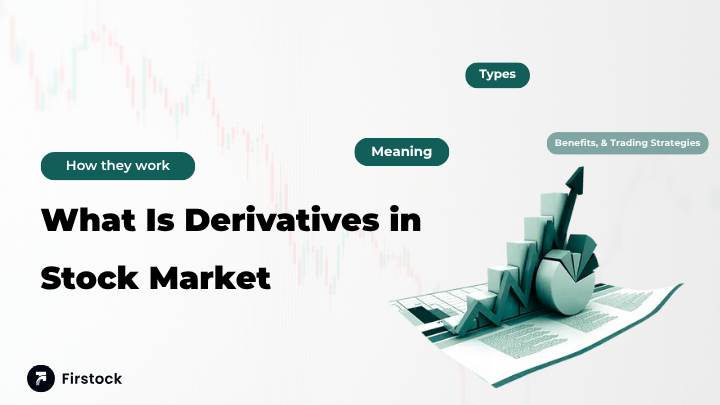Bollinger Bands | 4 strategies, Indicators & Formula for F&O

Bollinger Bands | Strategy, Indicator & Formula for Futures & Options
Have you ever asked yourself what traders mean by trading a stock that is too high or too low? The Bollinger Bands is one of the tools that have been used by many. In this paper, we will demystify the Bollinger Bands: What they are, how they are derived, how you could use them (at least with futures and options trading) and how a site like Firstock can assist you in applying them to your trades. We are going to make it easy, cordial and sensible--no technicalities, just common sense. Imagine Bollinger Bands like a rubber band around price: as it goes way out, it could be about to become something big; as it becomes tight and narrow, the peace could be coming to an end.
What are Bollinger Bands?
At its heart, the Bollinger Bands indicator is a way to see how volatile a market is and whether the current price is “too high” or “too low” in a relative sense. In simple terms:
- A middle line (usually a moving average) tracks the average price over a certain period.
- Then there are two lines (upper band and lower band) that sit above and below this average, at a set number of standard deviations away.
- The width of the bands expands when price moves wildly, and contracts when things are calm.
Imagine a rubber band around a group of dancing people: when they’re moving wildly, the band stretches; when they’re still, the band shrinks. That’s essentially what Bollinger Bands capture for price action.
Who invented them & why they matter
The idea comes from trader and analyst John Bollinger, who developed the bands in the early 1980s as a tool to answer a simple question: Is the price high or low on a relative basis? They matter because:
- They give you a dynamic range instead of a fixed support/resistance line—so they adapt to market conditions.
- They help gauge volatility (how “wild” the market is being) which is particularly important in futures and options, where volatility can make all the difference.
- They’re versatile: they can be applied to stocks, futures, commodities, currencies, options.
For someone trading via Firstock (or any broker), understanding Bollinger Bands can help you spot trading moments with better context—not just “price went up”, but “price is hitting the upper band and volatility is high”.
The Bollinger Bands formula
Time for some basic maths (but don’t worry—we’ll keep it light). The standard bollinger bands formula is:
- Middle Band = N-period Simple Moving Average (SMA)
- Upper Band = Middle Band + (K × Standard Deviation of the last N periods)
- Lower Band = Middle Band – (K × Standard Deviation of the last N periods)
Where:
- N = number of periods (often 20)
- K = number of standard deviations away (often 2)
So if you’re looking at a 20-day period, you take the average of the last 20 closing prices, then compute the standard deviation of those 20 closing prices, multiply by 2, and add/subtract that to/from the average. That gives you your upper and lower bands. Why standard deviation? Because that’s a measure of how much prices are spread out—more spread means larger bands.
How the bands work (indicator mechanics)
Understanding how Bollinger Bands behave can help you interpret them like you’d read traffic lights. Here are key points:
- When the bands widen: volatility is increasing—prices are moving more.
- When the bands tighten: volatility has dropped, the market might be taking a breather; this often precedes a bigger move.
- When price touches or goes beyond the upper band: it might be “relatively high” compared to its recent history (potentially overbought).
- When price touches or goes beyond the lower band: it might be “relatively low” (potentially oversold).
But—and this is important—these are not guarantees. Price can remain stretched, and trends can drive prices outside the bands for extended periods. So it’s a tool for context, not a standalone magic signal.
Typical settings for Bollinger Bands
So what settings do most traders use? A good starting point (and the default on many platforms) is:
- N = 20 periods (e.g., days if on daily chart)
- K = 2 standard deviations
These set-ups capture about 95% of past price action in a normal distribution model. However, you might see:
- Short-term traders using N = 10 and K = 1.5 for faster signals.
- Longer-term users choosing N = 50 and K = 2.1 or more.
The key is: match the settings to your time-horizon and risk profile. For example, in futures and options trading (which often moves fast), you might reduce N (so the moving average is more responsive) or even adjust K depending on how “twitchy” the asset is.
Using Bollinger Bands in futures and options trading
Here’s where it becomes even more interesting for you as a trader focusing on futures and options. Why? Because in these markets:
- Volatility often matters more than in simple cash-stocks.
- Timing (entry/exit) is more important—options can decay, futures carry costs.
- Price moves can be swift and large; Bollinger Bands help you gauge when things might stretch too far or be tightening.
How you might use them in futures & options:
- Entry trigger: If a futures contract’s price touches the lower band (suggesting relative “cheapness”), you might buy a call option anticipating a bounce.
- Exit trigger: If you’re long and the price hits the upper band, maybe that’s a cue to take profit (or tighten your stop).
- Volatility squeeze: If the bands narrow drastically (in a futures contract), it might signal an upcoming breakout; that could be an opportunity for options to buy straddles or strangles (betting on big movement).
- Hedging: Suppose you own futures and expect lulls; if bands are wide (high volatility) you might choose options-based hedges rather than direct futures.
Using a trading app like Firstock makes this smoother: you can overlay Bollinger Bands on futures/option charts, filter by volatility, set alerts when bands tighten, etc. It gives you actionable insight.
Popular Bollinger Bands Strategy
Here are some simple yet widely used bollinger bands strategy. These are not guarantees—but starting points.
Reversion to the mean
- When price hits upper band → consider selling (or buying a put) because price may revert back toward the middle band (the moving average).
- When price hits lower band → consider buying (or buying a call) because price may move back up toward the middle. This works well in range-bound markets.
Breakout strategy
- If bands have been very tight (low volatility), then a sudden expansion may signal a strong move starting.
- Strategy: watch for the “squeeze” (bands narrow), then look for volume or other confirmation that price is breaking out → you enter in the breakout direction (in futures) or buy an option for movement.
Trend-following with bands
- In a strong uptrend: price will often ride the upper band (hug it). In that case, you might wait for a pull-back to the middle band and then enter long.
- In a strong downtrend: price hugs the lower band, and you might look to sell or short when price returns toward the middle band.
Using the band width
- If the band width is very small (bands squeezed), volatility is low—potential for a big move.
- If the band width is very large, volatility is high—risk is higher, so you might adjust your position size accordingly.
Mistakes to avoid when using Bollinger Bands
It’s easy to misuse any indicator—so here are common pitfalls with Bollinger Bands and how to avoid them:
- Assuming price outside the bands always reverses: Not true. In strong trends, price can ride outside the band for extended periods.
- Using bands alone: Bollinger Bands give context, but they won’t tell you direction with certainty. Use other tools too.
- Ignoring time-frame: A 20-period band on a 5-minute chart behaves differently from a 20-period band on a daily chart.
- Over-reacting in fast markets: In futures or options, rapid moves may break bands violently; you must manage risk.
- Setting unrealistic expectations: The bands measure relative price to history—not guarantee of reversal. John Bollinger himself cautions against over-interpreting the tool.
How to use Bollinger Bands on Firstock platform
If you're using Firstock to trade futures and option trading app, here’s how you can make Bollinger Bands work for you:
- Add Bollinger Bands indicator: In the charting section on Firstock, select Bollinger Bands (usually under "Technical Indicators").
- Choose your time-frame: If you’re trading intraday futures, you might use 15-minute or 5-minute charts. If you’re trading options for a few days, daily charts may work.
- Set parameters: Start with N=20, K=2 as a standard. Then adjust if you find your asset behaves differently.
- Monitor band width: If you notice a clear “squeeze” (bands narrowing significantly), mark it for possible breakout opportunity.
- Watch band touches: When price hits upper or lower band, see if other signals (volume, trendlines, RSI) support a reversion or breakout.
- Risk management: Use stops or option hedges. If you trade futures, know your margin and exit strategy.
- Review past data: Use Firstock’s chart history to back-test how Bollinger Bands worked for specific futures/option contracts you trade.
By integrating Bollinger Bands into your routine with Firstock, you turn them from a theoretical concept into an actionable part of your trading toolkit.
Combining Bollinger Bands with other indicators
To make Bollinger Bands more effective, you should pair them with other indicators or tools. Here are some combinations that work:
- Volume: A breakout beyond the bands accompanied by high volume is more trustworthy.
- RSI (Relative Strength Index): Use RSI to confirm if the asset is overbought/oversold when bands touch.
- MACD (Moving Average Convergence Divergence): A trend momentum indicator can tell you if price is likely to keep going or reverse.
- Support/Resistance lines: If band touches coincide with established support/resistance levels, the signal is stronger.
- ATR (Average True Range): To gauge how much the price typically moves—important when bands widen.
Think of Bollinger Bands as your “map of terrain”, and the other indicators as “traffic signals” telling you how to behave.
When Bollinger Bands may not work well
No tool is perfect—and here are scenarios where Bollinger Bands might mislead you:
- During sharp, sustained trending markets: Price may stay near the upper or lower band for extended periods, giving false reversal hopes.
- In illiquid markets or low-volume futures/options: The standard deviation may not reflect real volatility, bands may behave erratically.
- When using improper time-frames: If your time-frame doesn’t match your trading horizon, the signal might be too noisy or too slow.
- If you ignore context: Just because price touches the band doesn’t mean you automatically act—context matters.
- During major news events or gaps: Volatility may explode outside of what the bands indicate—be prepared.
Summary and takeaway for the everyday trader
To wrap it up: Bollinger Bands are like a flexible envelope around price—they show you how “stretched” or “compressed” the market is. For traders in futures and options (such as those trading via Firstock), they’re especially useful to:
- Gauge when volatility is low (and maybe a big move is coming).
- See when price may be “relatively high” or “relatively low”.
- Combine with other tools for better trading decisions.
Remember: they’re a guide, not a guarantee. Use them thoughtfully, pair with risk management, and adapt your settings to your trading strategy. When used right, Bollinger Bands can give you an edge in understanding market rhythm—whether you’re trading a call option for a short-term move or planning a futures swing.
FAQs
1. What is the best time-frame to use Bollinger Bands?
There’s no universal “best” time-frame. If you’re day-trading futures, you might use 5-minute or 15-minute charts. If you’re trading options over days or weeks, daily charts might be better. The key is consistency and aligning the time-frame with your trading horizon.
2. How many standard deviations should I set for the bands?
The typical setting is 2 standard deviations (K = 2). But you might adjust: for tighter signals you could use K = 1.5; for longer-term smoothing you might use K = 2.5. Experiment, but always test before risking real money.
3. Do Bollinger Bands work in futures and options the same as stocks?
Yes, in a broad sense they do—they measure volatility and price relative to average. But in futures and options, volatility tends to matter more and moves can be sharper, so you may need to adjust settings or combine with other volatility tools.
4. Should I buy when price hits the lower band and sell when it hits the upper band?
That is one strategy (reversion to mean) and it can work in range-bound markets. However, it won’t always work (especially in trends). You’ll want confirmation from other indicators or context (trend, volume, news) before acting.
5. Can I use Bollinger Bands alone for trading?
Technically yes—but it’s risky. Most experienced traders use Bollinger Bands with other tools (momentum, volume, trend lines) and always apply risk management. The bands give you context, but not always direction or timing on their own.





